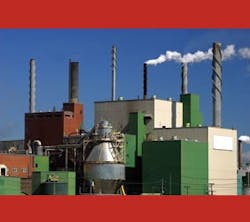Heavy Paper
The pulp and paper industry is one of the heaviest users of water within the North American industrial economy, requiring an average of 54 cu meters of water per metric ton of finished product. As water is used in nearly every part of the manufacturing process, accumulation of scale is a phenomenon that can occur in all pulp and paper making processes. This occurs even with the purest water and state-of-the art water treatment. The scale deposits can cause a number of operational problems such as plugging of equipment, inefficient usage of chemicals, increased utility costs, lost production due to downtime and downgraded products from increased dirt counts.
Types of Fouling
Scale usually refers to an intimate mixture of sparingly soluble mineral salts. Mineral scale deposition occurs as a result of heat transfer or pressure changes. Calcium carbonate (CaCO3) scaling from hard water, and calcium phosphate and oxalate formation are examples. Other types of fouling include the growth of algae and bacteria (biofouling), the consolidation of loose particles (particulate fouling, e.g., from corrosion byproducts), and the accumulation of “coke”-like deposits (an example of chemical reaction fouling).
Processes affected by scale formation include:
De-inking lines. Water used in this process contains large amounts of salts (carbonates; oxalates and silicates of calcium, magnesium and aluminium; and other soluble materials and chemicals). These salts cause scaling within the pipe, filters and pressure screens. One particularly problematic area involves disc fillers where scale builds up, resulting in a lack of hydraulic pull-through. The pipe and filter bags need descaling and high-pressure cleaning during plant shutdown, normally every six months. In addition, cleaners and screen baskets require descaling every three months. Blockages frequently occur in screen baskets, showers and pipes, causing a substantial loss
of production.
Drying cylinders/vacuum pumps. Steam required for heating paper machine drying cylinders causes condensate, which is collected in separators. The vacuum pump draws the incondensable gases from the top of the main separator to prevent air locks. Limescale buildup occurs in the vacuum pumps, caused by the high temperature of the condensate.
Water treatment plants. Most paper mills have water treatment plants, with many using borehole water, which has high levels of calcium carbonate. Despite the use of acid dosing, plants generally suffer from scale, necessitating water treatment alongside the dosing. Not only is the process expensive, but acid dosing also causes corrosion.
Green liquor lines. Regular shutdown of lines due to scale buildup is a regular problem. This often necessitates hydro-blasting the lines to remove the hard scale.
Paper liquids. Paper liquids with a CaCO3 concentrate of 10% to 15% are often pumped out from a header tank through a 3-in. pipe. The liquid is diverted into four separate lines with a vibrating feeder attached to the end of each line. The high concentrate of CaCO3 means that regular cleaning needs to be carried out, sometimes up to twice a day.
Air humidifiers. Standard temperature and humidity are required for stored paper and provided through air humidifiers. Freshwater is fed to a perforated rotary drum by the humidifier, vaporized and partially carried away by the airflow passing through the drums. Residual water drops down and then is reused. Scale buildup on the jets and filters necessitates their replacement and results in increased energy costs.
Black liquor evaporators. Black liquor contains sodium, carbonate and sulfate. As liquor dry solids increase, so does the concentration of these minerals until their solubility is exceeded. Salts then crystallize from the liquor and deposit on the heat transfer surfaces of the evaporator. The scale produced reduces the rate of heat transfer and the evaporation effect.
Heat exchangers. The deposition of material on heat transfer surfaces is called fouling, which significantly impacts the thermal and mechanical performance of heat exchangers. Fouling increases the overall thermal resistance and lowers the overall heat transfer coefficient of heat exchangers as well as impedes fluid flow, accelerating corrosion and increasing pressure drop across the heat exchanger.
Electronic scale removal. Regardless of how hard water effects are achieved, the outcome is the same. Scale formation results in reduced diameter or blocked pipe, reduced heat transfer efficiency, seized pumps, inoperarable valves, misleading meter readings and defective heating elements. All of the above processes within the pulp and paper industry have proven treatable with electronic scale removal, saving money on chemicals, maintenance and downtime.
Electronic water conditioning. The technology works by producing a complex frequency modulated waveform, inducing an electromagnetic field inside the pipe. Scientific research shows that specific electromagnetic fields initiate colloidal cluster regrouping in the very first stage of crystallization. CaCO3 results from the interference, which means it no longer has the tendency to form a matted structure (fouling or scaling) but becomes scattered particles that will be flushed out by the medium.
As there is no more scale buildup, the flowing water will remove existing layers of scale over time. This mainly is caused by diffusion according to the law of mass action. After electromagnetic treatment, hard water is capable of dissolving and removing existing scale layers.
Electronic water conditioning products affect the formation of scale by increasing the homogeneous precipitation rate of CaCO3 and certain other minerals. The ability to adjust power, frequency and coil configurations on site enables performance to be optimized without downtime or pipe replacement.
The pulp and paper industry is facing extreme pressure to improve overall operation efficiency. Cluster rules and other environmental factors, in addition to economic factors, are forcing the pulp and paper industry to drive operating systems well beyond their design maximums, exacerbating the problems of scale buildup and plant shutdown. The types, sources and areas where scale can accumulate in pulp and paper mill processes are quite diverse. While more system closures may exacerbate scale problems, technologies have been developed that can be used to overcome those problems.
Download: Here
